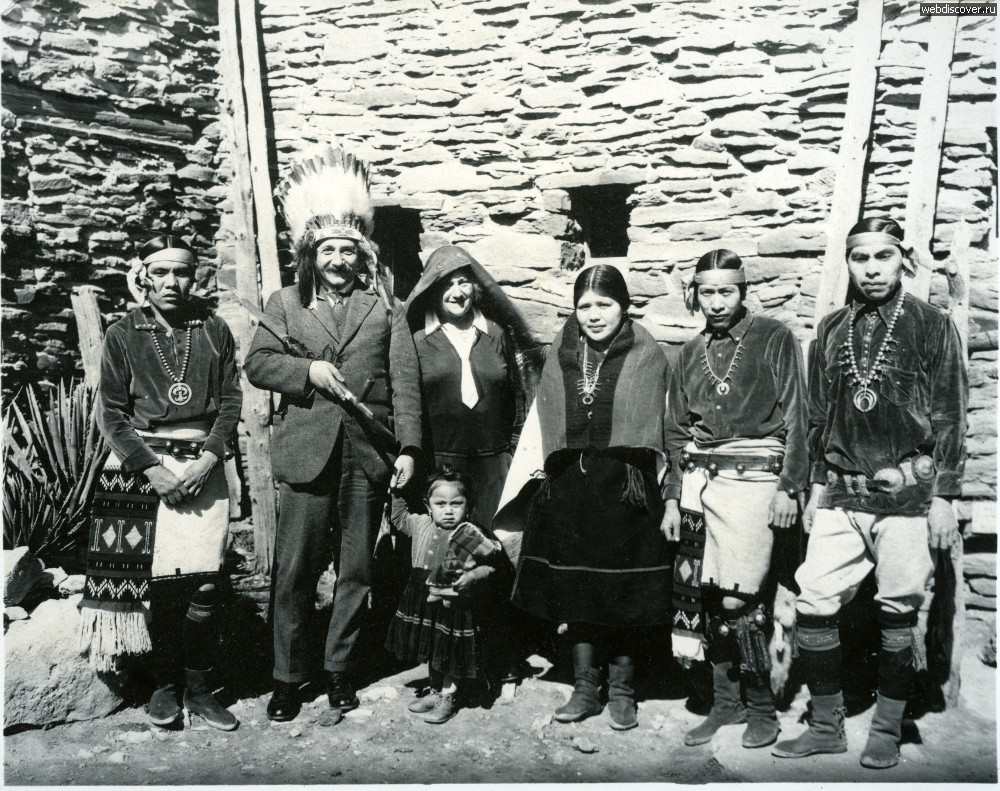Ask Experts
Soul Surfing
Path Finder
Albert Einstein at Hopi House
27 Jan 2013 Albert Einstein visits Hopi House at the Grand Canyon, 1931.
Albert Einstein visits Hopi House at the Grand Canyon, 1931.
Photo by El Tovar Studios
Courtesy of Museum of Northern Arizona Photo Archives (78.0071) and
Museum of New Mexico Photo Archives (38193)
Albert Einstein at Hopi House
Albert Einstein made his second trip to the United States in the period between December 1930 and March 1931 to spend some time at California Institute of Technology, one of the institutions that was courting him to join their staff. It was on the return trip across the U.S. by train that the above photograph was taken. There are several striking things about this photograph that deserve mention. It is clear that the headdress that has been placed on Professor Einstein’s head and the pipe he has been given to hold have no relationship to the Indians in this photograph. These Indians are Hopis from the relatively nearby Hopi pueblos while the headdress and pipe belong to the Plains Indian culture. The actual location of the photograph is Hopi House, a part of the Fred Harvey concession at the Grand Canyon. The studio that took the photograph was associated with the El Tovar Hotel, at the Grand Canyon. The two buildings sat side by side with Hopi House, designed by Mary Colter, being used for the display and sales of Native American crafts. Many of the crafts people hired by the Fred Harvey Company, such as Nampeyo and Fred Kabotie, are among the most highly regarded Native American artists of their generation. The Hopis in this picture were employees of the Fred Harvey Company who demonstrated their arts there and, no doubt, posed for many other pictures with tourists.
Besides Albert Einstein and his wife, there are 3 adult Hopis and one Hopi child in the photograph. Einstein is holding the hand of a young Hopi girl in a very natural manner; she is clutching something tightly in her other hand and is quite intent upon something outside the frame. Prof. Einstein’s attraction to children is seen in several other unofficial photographs. He loved children and felt quite comfortable with them. The two men on the left side of the photograph were there to facilitate the Einstein’s trip. The man on the left is J. B. Duffy, General Passenger Agent of the ATSF (the famous Atichson, Tokepa and Santa Fe Railroad); the other man is Herman Schweizer, Head of Fred Harvey Curio, normally stationed in Albuquerque. He may have spoken German and was therefore present because Prof. Einstein was not completely comfortable yet with English.
None of the Einstein biographers that have mentioned this photograph have the location correct. Most place it at “the Hopi Reservation at the Grand Canyon.” In fact, the Hopi Reservation lies approximately 100 miles east of the site of this photograph. One biographer says that Einstein was embarrassed by being given the name “The Great Relative”. Another claimed that he was smirking in the photograph. (We have examined a large scale poster of the photograph in great detail and find that no such statement can be made since his mouth is in full shadow!)
It isn’t possible to know how the Einsteins felt about this encounter. However, he does seem comfortable here, even if his wife does not. He probably is not concerned about saying the wrong thing and embarrassing his hosts as happened in Pasadena, where his pacifist views were disturbing to rich conservatives being courted for contributions to CalTech. He has probably not been asked to give a one sentence explanation of relativity theory either. It is also unknown whether he had any knowledge at all of American Indian culture(s). Did he know that the headdress and pipe were entirely unconnected with the Indians in the photograph? All we know is that he could (and did) speak of his heritage as tribal; his politics were definitely unconventional, and he was entirely unable to control the use of his own image. At this time, his presence (silent, preferably) was desired as a badge of approval by many people and organizations, both political and scientific. Later, his easily recognizable image would be appropriated for use in commercials for beer, hosiery, electric companies and other disparate items.
With fame I become more and more stupid, which, of course, is a very common phenomenon. There is far too great a disproportion between what one is and what others think one is, or at least what they say they think one is. But o ne has to take it all with good humor.
Another such publicity photograph taken at Hopi House, Madame [Luisa] Tetrazzini, famous opera star, posing with Indians of the Hopi House, is available from the Cline Library at Northern Arizona University. http://www.hanksville.org/sand/Einstein.html
Source : http://www.hanksville.org/sand/Einstein.htmlut
image source : http://webdiscover.ru
@soulpark_in
Feeds
Susbscribe to our awesome Blog Feed or Comments Feed

